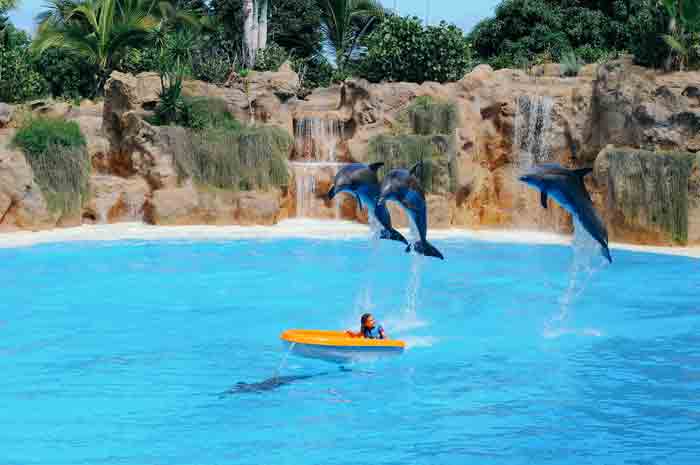IELTS Speaking Part 2: IELTS Cue Card
Describe an aquatic animal.
You should say
What it looks like?
When did you see it?
Where you saw it?
Explain why it is interesting?
Note: You will have to talk about the topic for one to two minutes. You have one minute to think about what you are going to say. You can make some notes to help you if you wish.
Model Answers and follow up questions to describe an aquatic animal with IELTS cue card:
Model Answer 1
Introduction:
Well, I am quite interested to learn about aquatic animals as they are pretty unique in nature and appearance. For example, sea horses, starfishes, octopuses and so on, but here I would like to talk about my all-time favorite, “Dolphin.”
When did you see it? and Where you saw it?
I saw this animal for the first time in my school book when I was in 3rd class, and I got captivated by the impressive looks of this fish.
What it looks like?
Dolphins are usually large in size and can be found in different colors like white, grey and black. They have a very smooth body line and fins that move like hands. Recently, while watching a show on the discovery channel, I got to know that they are the most intelligent living creature.
Explain why it is interesting?
They are highly social and often found in groups. In fact, they have developed a language as well to communicate with others. The best thing about this animal its ability to jump out of the water and dance on its tail, this is perhaps the reason why they are used in entertainment industry today where they dance, play with balls and create funny noises to entertain the audience especially children.
Conclusion:
Since, I like dolphin so much so, it is my wish to see it with my naked eyes at least once.
Model Answer 2
Introduction:
An aquatic animal is an animal, either vertebrate or invertebrate, which lives in water for most or all of its lifetime. Marine animals may breathe air or extract oxygen dissolved in water through specialized organs called gills or directly through the skin.
What it looks like?
The body of an octopus looks like a bag. It also has a bulbous (Something that’s bulbous is round) head, eight arms, and large eyes. The arms have many nerves, which allow the octopus to grab and taste things. Octopuses inhabit various regions of the ocean.
Most species of octopus grow quickly, mature early, and are short-lived.
The giant Pacific octopus is often cited as the largest known octopus species. Adults usually weigh around 15 kg.
When did you see it? and Where you saw it?
Last month I went to Delhi for some official work/ for the exam. I visited my friend’s house at night. He is very fond of animals and birds. He has many pet animals and birds at home. He has recently bought octopus and make the proper place and create the appropriate environment for it. It is a baby octopus looks very lovely.
Explain why it is interesting?
Octopuses are brilliant animals, masters of camouflage/ hide that have tricks over tens of millions of years to avoid or thwart would-be attackers. They can match their surroundings’ colours and even textures. If a predator gets too, close octopuses can escape quickly.
Also, the octopus’s arms are lined with hundreds of suckers, each of which can be moved independently and letting the animal touch, smell, and manipulate objects.
Model Answer 3
Introduction:
- India has a diverse animal life.
- We have wild animals, domestic animals, and pet animals.
- I am going to talk about an animal which I find very interesting.
What it looks like?
- This animal lives in water but is not a fish.
- It is a mammal – it is the dolphin.
When did you see it? and Where you saw it?
- The first time I came to know about this animal was from the National Geographic channel.
- This river dolphin is the national aquatic animal of India.
- It gives birth to its young one and suckles to feed it.
- It cannot breathe underwater, so it has to come to the surface to breathe.
- Even the little dolphin baby has to be pushed to the surface to breathe.
- Dolphins feed on most kinds of fish such as the snapper and the tuna.
- Dolphins are fast swimmers.
- They search their way through the sounds they produce, which is called echolocation.
- The dolphins’ sound waves hit an object, and the echo bounces back.
- Most dolphins are peaceful and somewhat shy.
- So far, humans have proven to be of greater danger to dolphins than the other way round.
- Marine dolphins are found in oceans, and river dolphins are found in rivers.
- Like the tiger is our national animal and the peacock is our national bird, the Gangetic river dolphin is our national aquatic animal.
- The Indian river dolphin is blind.
- It is found in the river Ganges.
- The female is about 9 feet long, and the male is about 7 feet long.
- Unfortunately, our river dolphin is on the verge of extinction.
- However, now the government has started taking steps to save it under the ‘Project Dolphin’.
Explain why it is interesting?
- Dolphins are essential for maintaining the ecosystem.
- I recently saw a Hindi movie Ajooba in which Amitabh Bachchan is rescued by a dolphin and considers the dolphin as his mother.
- I came to know from that movie that dolphins are very intelligent and can be trained.
- So, this is the aquatic animal, which I find very interesting.
IELTS Speaking Part 3 : Follow up Questions
Here some examples of follow up questions that you may asked during your speaking part 3 by examiner related to cue card “describe an aquatic animal”.
1. Why do people like to keep pets?
Spending time with pets is the best way to reduce stress and anxiety levels. Several studies/researches have revealed that people who tend to spend their time with pets are more likely to live longer than people who don’t. That’s the way they like to keep pets
2. What should we do to protect endangered animals?
This kind of work required many funds to donate some money to NGO to protect endangered animals. We can educate our society and family about endangered species. Moreover, we can motivate people to keep the environment clean and try to use a recyclable product.
3. Do you support doing experiments on animals?
Even though Animal models help ensure the effectiveness and safety of the new treatment, animals suffer a lot of pain and other types of infection, so I do not support animal experiments.
4. Why do some people refuse to eat animals?
There are many reasons people refuse to eat animals such as some people are pure vegetarian, so they do not eat animals, another reason is religion, in India, people worship animals such as cow, so that’s why they don’t eat animals. Moreover, non-vegetarian food contains lots of fat, so people who are health conscious do not eat animals.
5. What would happen when some species disappear on earth?
There can be many negative consequences if some species become extinct on our planet. The first effect is that there will be an imbalance in the ecosystem. For example, if mosquitoes disappear forever, other creatures can suffer as a result because they become hungry, like frogs or lizards, which usually feed on mosquitoes.
Some cue-cards you may like :
- Describe an old object which your family has kept for a long time
- Describe a time when you felt awkward
- Talk about a happiest person that you know
- Describe a piece of international news you have just recently heard
- Describe your first day at school
Credits :
Photo by Krzysztof Kowalik on Unsplash





